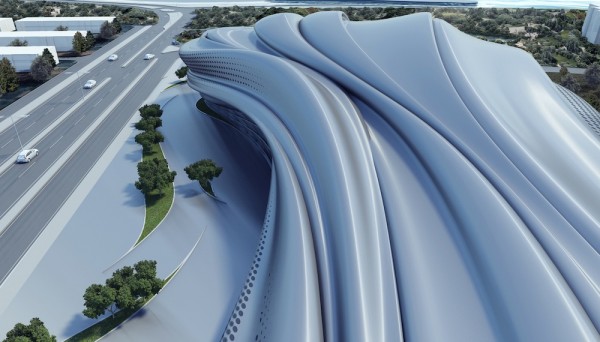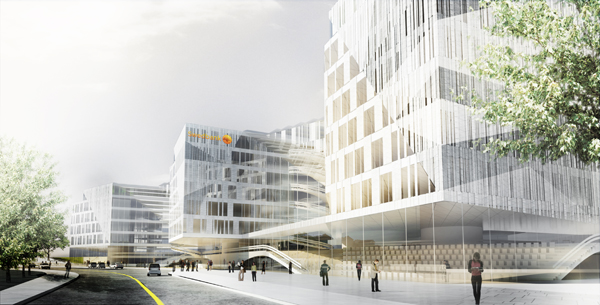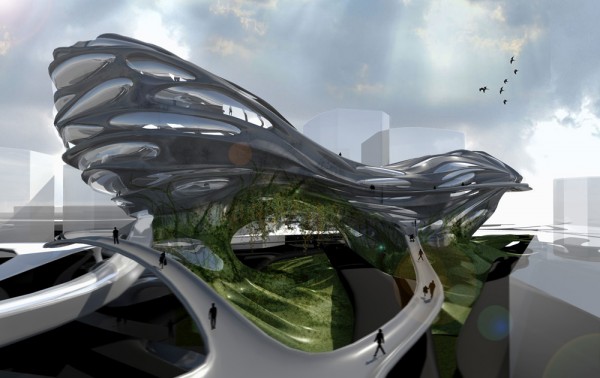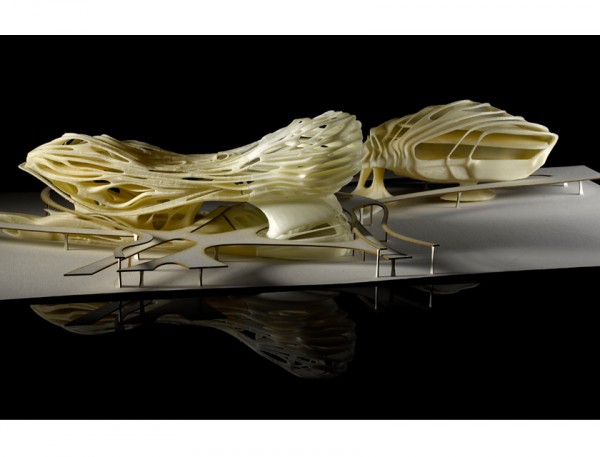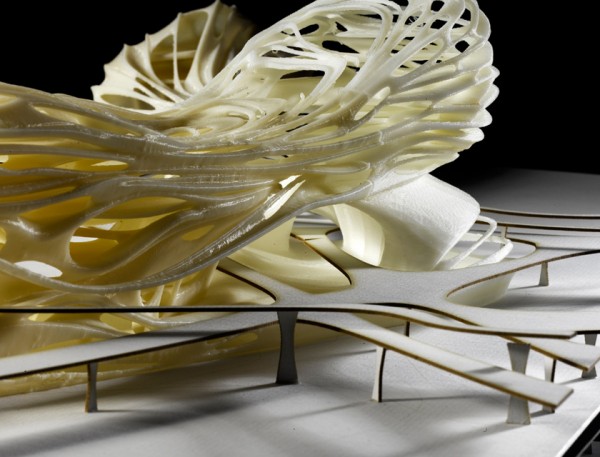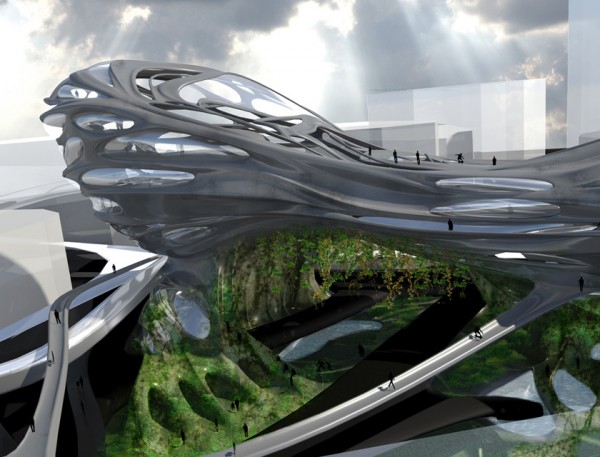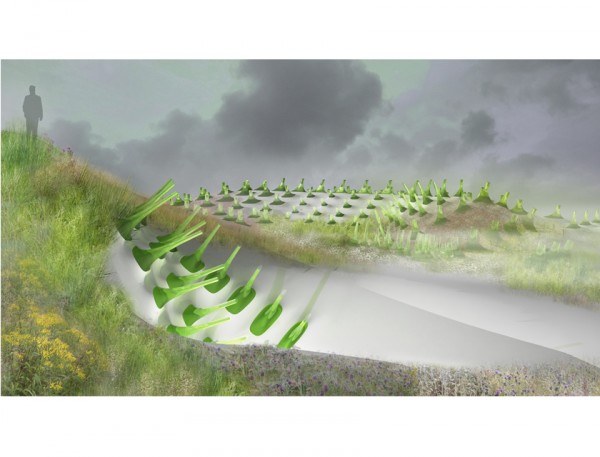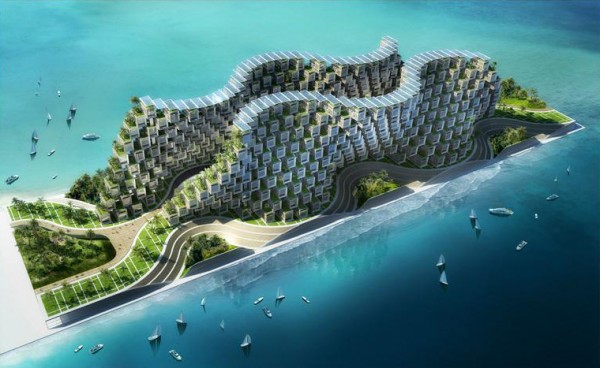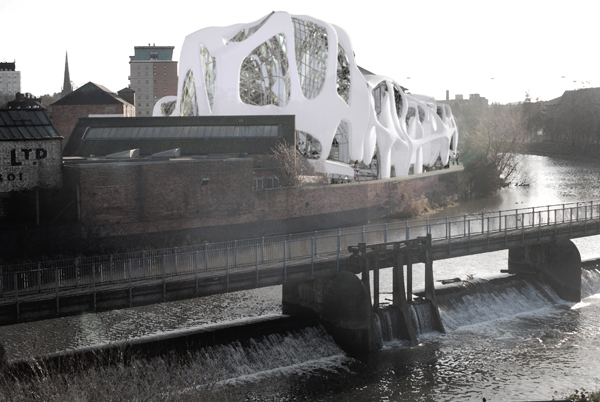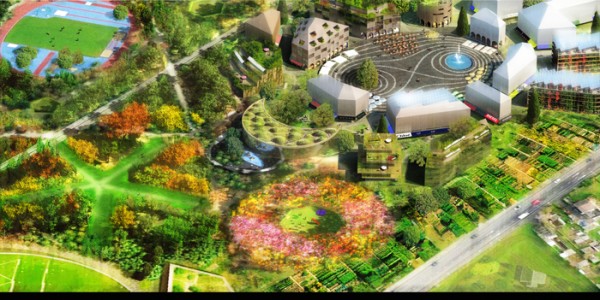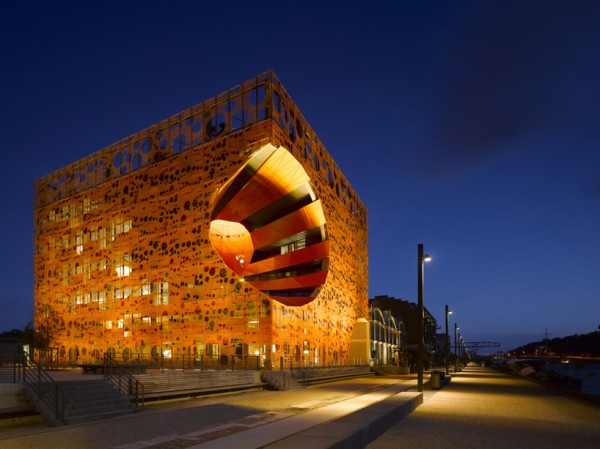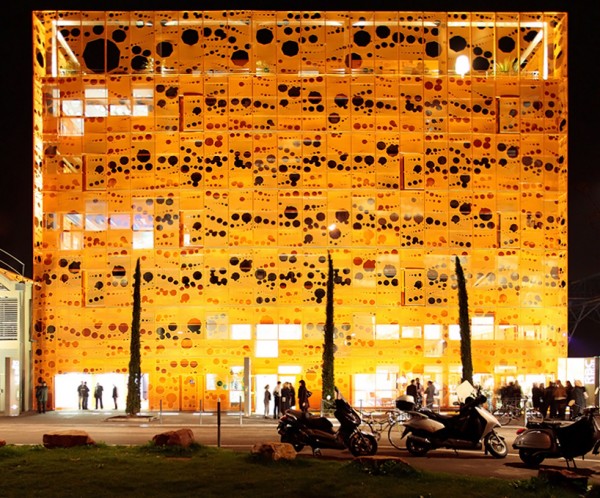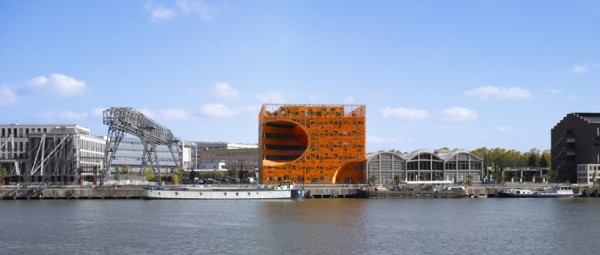The Cultural Campus designed byKadri Kerge, Jelena Vukmirovic, and Melanie Kotz is to be located near Ismailia, 80km north-east of Cairo, is a self sustainable organism, dealing with extreme climate. The campus consists of a School of Performing Arts (Music, Dance), a School of Visual Arts, a Residence Complex to house students and staff, a Performance Center for Music and Dance and a Contemporary Art Exhibition Gallery. The project is seeking for a new way of creating a modern campus by rediscovering typologies of private and public spaces, and connections between them. Read the rest of this entry »
Self-sustainable Cultural Campus in Ismailia, Egypt
Opera House in Izmir, Turkey
Art has a great role in showing what happens in human beings’ life. Soul, intelligence and the emotions are the reflections of the community, and Art forms the social identities of communities. It also shows us the difference between the various social identities. Global influences effect the types of knowledge acquisitions or the social values in the art, and the artists determine the standards of modern life.
Thus, art centers have many roles beside their fundamental functions that should be participant, shared with society and create a modern level in connection between the citizens and the artists’ works. This concept is the key criteria for the Izmir Opera House Project designed by Emrah Cetinkaya. The project should be reflecting the history, the culture and the modern life in Izmir, furthermore it should be an identity for the city of Izmir.
And competition area also allows us to create an identification or a symbol for a city that because the area can be seen clearly from near surroundings and specially from sea side areas. This situation came to the forefront. So we considered important in it.
Izmir opera house has been designed for being a symbol for izmir. In this way, we thought that izmir will be a center of attraction and also first recognizable preparation place for all domestic and foreign tourists. Read the rest of this entry »
3XN is to design Swedbank’s New International Headquarters
The new Headquarters will be one of Sweden’s most modern and innovative office buildings – focusing on transparency, Scandinavian simplicity and dynamic social environments. Behind the project is the Danish Architect 3XN in collaboration with Humlegården Fastigheter, representing the property owner Länsförsäkringar Liv.
By the end of 2013 no less than 2.500 co-workers will move into the innovative building at Sundbyberg Stad near Stockholm. The Headquarters is designed by the Danish studio 3XN with direct reference to Swedbank’s core values; openness, simplicity, care and durability.
3XNs Principal Kim Herforth Nielsen explains: “The building is conceived and designed from the inside out. We have literally translated Swedbank’s core values into the creation of a modern and groundbreaking head office. Swedbank has conveyed the importance it places on creating an open social environment, which happens to coincide with 3XNs design beliefs and ideology. It has been a very interesting process and we look forward to getting to work on the project.”
With its innovative and transparent expression formed in an unconventional triple-v structure the building will become a landmark among Swedish office buildings. The large volume is broken up to create spaces on a human scale. This makes the building inviting on the inside as well as on the outside. Read the rest of this entry »
Architecture Designed to Simulate Self-organizing Biological Systems
This project designed by Arthur Azoulai and Melody Rees is a morphological study that assumes an extended field of movement and circulating forces. It is designed by simulating self-organizing biological systems where selective decision making is used to sculpt innate yet deliberate spatial relationships and formal qualities. At its pure essence, this project is an infrastructural system that acts as a receiver and link-up for formal architectural systems. The inherent continuity of the overall form as a topological surface allows for the emergence of roadways, interstitial interior space, and landscape.
With imbricating structural support systems, the collective tectonics provide a network of circulation paths for pedestrians, cars and trams in addition to an emphasis on temporary pavilion spaces such as transitory food markets, pop-up retail shops and time-share housing. With a temporal and ephemeral program the local culture of Santurce in San Juan becomes active. Correspondingly, the adaptive qualities of the infrastructural surface allow the building and site form an organic semiotic relationship where the building seamvlessly emerges from the land below. This is emphasized as the ecologically evasive character of Puerto Rico’s environment merges into the architecture. Thus this project articulates new formal relationships and interstitial space while also reflecting the contingencies of the current moment in San Juan, Puerto Rico.
via suckerPUNCH
Cartesian Wax – Prototype for a Breathing Skin / Neri Oxman
This project by Neri Oxman from the MIT Media Lab explores the notion of material organization as it is informed by structural and environmental performance. A continuous tiling system is differentiated across its entire surface area to accommodate a range of physical conditions of light transmission, heat flux, stored energy modulation and structural support. The surface is thickened locally where it is structurally required to support itself, and modulates its transparency according to the light conditions of its hosting environment. 20 tiles are assembled as a continuum comprised of multiple resin types – rigid and/or flexible. Each tile is designed as a structural composite representing the local performance criteria as manifested in the mixtures of liquid resin. A single 3-D milled semi adjustable mold made of machinable wax is used to generate multiple tiles. Each tile is cast with high temperature curing plastic deforming the original mold with each casting procedure by controlling the temperature gradient across the surface area of the mold. These processes speculate about light and/or heat sensitive environmental-specific construction techniques. Read the rest of this entry »
Bioscience Innovation Center with a Hydrodynamic Vegetated Roof / SERVO
This speculative proposal by SERVO for a 4,000 sqm bioscience innovation center with a hydrodynamic vegetated roof, located in the Albano region of Stockholm, reconsiders the extensive green roof typology to produce an occupiable roofscape characterized by immersive depth. The green roof is designed to be experienced from several vantage points: from above—walking amidst a dense landscape of indigenous vegetation intertwined with protuberant forms that emit water, air or light; from below—as a suspended ceiling system that pulls down to close proximity with the floor; or from within—in the interior of the auditorium space and specialized laboratory areas designed for the cultivation of vegetation in semi climatically-controlled microclimates. Read the rest of this entry »
Coral Reef – Matrix for the Construction of 1000 Passive Houses in Haiti / V. Callebaut
Called “The Pearl of West Indies”, Haiti was during a long time the most visited country of the Greater Antilles representing the occidental third of Hispaniola Island. Devastated in 2010 by an earthquake measuring 7.0 on the Richter scale, the country has now to be rebuilt from new innovative architectural and town-planning concepts.
The Coral Reef project designed by Vincent Callebaut Architects plans a matrix to build a three dimensional and energy self-sufficient village from one and only standardised and prefabricated module in order to rehouse the refugees from such humanitarian catastrophes. This basic module is simply made of two passive houses (with metallic structure and tropical wood facades) interlocked in duplex around a transversal horizontal circulation linking every unit.
Inspired from a Coral reef with fluid and organic shapes, the overall project presents itself as a great living structure made of two waves dedicated to accommodate more than one thousand Haitian families. These two inhabited waves undulate along the water on an artificial pier built on seismic piles in the Caribbean Sea. From concave curves to convex curves, the housing modules are aligned and piled up by successive stratums such as a great origami. Between the two inhabited waves is created a sumptuous interior canyon in pixels with terraces and cascades of food gardens.
Actually, the laying-out in staggered rows of the plane-parallel base modules enables to superimpose the passive houses in cantilever and to multiply the vision axes towards an endless number of perspectives. Each roof of each module becomes then an organic suspended garden enabling to each Creole family to cultivate its own food and to use themselves their own wastage as compost. Read the rest of this entry »
Ref-Urb Ref-Ind Block – Vertically Integrated Community
Johan Voordouw is a member of the research network Horhizon, a London based collaborative that conducts research through design. This project seeks to establish urban communities through the re-interpretation of existing urban typologies.
Like many mid-sized cities across Western Europe the loss of manufacturing has resulted in continual economic decline. Leicester is but one of the many examples of cities in the United Kingdom that has increasingly suffered from the loss of industry and the inability to attract service industries due to its close proximity to larger centres such as London, Birmingham, Manchester and Liverpool.
This project seeks to build a vertically integrated community with a common purpose away from a service led economy and assert a new, small-scale industrial complex intimately linked to housing and retail. The community is a re-interpretation of traditional typologies such as the scale of the Victorian terraced house, the layout of the urban mansion block and the programme of the traditional market village. Bounding the site are urban vectors such as a High Street, and pedestrian pathways along the canal network.
This community will simultaneously densify the city while retaining all the facets for a viable community as a place to work, live and play. Read the rest of this entry »
Masterplan for Niderfeld, Dietikon Switzerland / Kubota Bachmann Architects
Kubota & Bachmann Architects unveiled their masterplan for Niderfeld, Dietikon Switzerland. In order to improve the district’s performance, the future identity of Niderfeld shall be developed gradually and reflect the district’s diversity. Wherever required by the districts’ identity, leading principles shall govern the arrangement, the volumetry as well as the formation. This regards the housing, the landscape and public space. Concerning the urban development and architecture, conditions shall be set that motivate the residents to lead a sustainable lifestyle. The objective to allow Niderfeld a multiple identity is achieved by the interaction of different development scenarios. To honor those identities, a multidimensional public space surrounds the buildings. By promoting a differentiated social as well as urban development, those measures will ensure Niderfelds’ success. Not every accumulation of buildings constitutes a city in itself. To create a harmonious overall concept contributing to the districts’ identity, every building has to be understood as part of an urban master plan. Thus, the development process takes account of the existing buildings and integrates it in the big picture.
The typological diversity of the concept and the gradual development facilitate the integration of existing structures (i.e. the Grabacher building). The development may respect individual needs of real estate owners and start from out different places. Through the intended ecological efforts, Niderfeld meets future environmental standards. The concept incorporates possible changes of sociological and demographical nature and adaptation is possible in the course of time. The multi-story car parks might be converted given that they are built above ground. Buildings and their façades might be produced out of wood. So instead of emitting carbon, it will be sequestrated in the building material. Roofs shall either serve as vegetation surface or be equipped with solar panels. Read the rest of this entry »
Orange Cube Brings Life to Lyon, France / Jakob + MacFarlane
Designed by Jakob + MacFarlane as a part of an urban planning project to replenish the docks of lyon, the five-storey orthogonal cube plays off the fluid movement of the river saône, exploring the effects of subtraction and voids on the quality and generation of space. Built on a regular framework of 29 x 33 m, the structure stands autonomously on the site, a wharf with a predominantly industrial background. The most noticeable element of the design – its bright orange shade – is an abstraction of lead paint, an industrial color often used for harbor zones. The external skin is a light facade, punctured with a pixilated pattern that resembles trailing droplets, a reference to the adjacent river’s flow. This porous envelope allows sightlines and natural daylighting while establishing a distinct identity for the building.
The structural regularity of the cube is broken on the north-west corner which faces the river. Conic in form, the large, diagonally-running void generates new space: a large atrium is created which is circumscribed by a series of outdoor corridors that connect the office platforms together. The facade is pulled into the depth of the volume, resulting in a shift in interior/exterior relations, as well as facilitating light and views. Another volumetric subtraction on the entry and roof level establish direct relations between the building, its users, and the site.
Featuring a double-height layout, the ground floor accommodates a design showroom. The display concept, which was also created by jacob + macfarlane architects, was developed as an extrapolation of the ‘orange cube’s architectural language. taking the treatment of the facade, a three-dimensional volume was generated for an L-shaped wall that wraps around the space. Sixty ‘alvéoles’ are used to display furniture pieces, while the unit as a whole define the circulation of the floor.
Images ©Nicolas Borel


